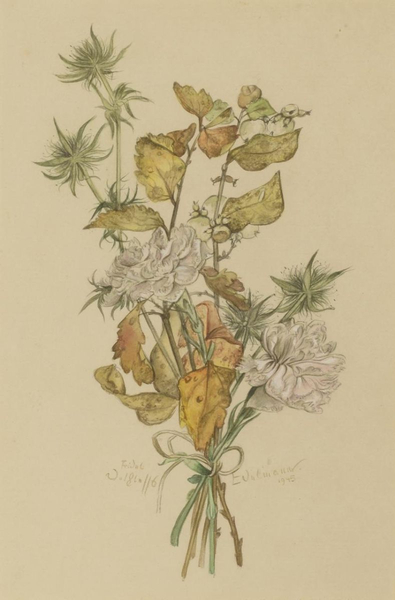- Home
- Works in Exhibitions
- Fridel Dethleffs-Edelmann
- Ursula Dethleffs
- Treasures from the Collection
- Collection of art
- Watercolor
- Tapestry
- Collage
- Gouache
- Reverse glass painting
- Glass church window
- Glass Mosaic
- Ceramic Plate
- Ceramic Picture
- Ceramic Relief
- Ceramic Sculpture
- Mixed media
- Object Art Relief
- Object Art Sculpture
- Oil Paintings
- Repro Lithography
- Repro Glass Lithography
- Repro Woodcut
- Repro Linocut
- Repro Monotype Printing
- Repro Etching
- Tempera
- Drawing Brush
- Drawing Brush Repro
- Drawing Ink and Pen
- Drawing Crayon
- Drawing pencil and crayon
- Exhibition by Period
- FDE: Selfportraits
- Introduction to the work of Ursula Dethleffs
- The collage as a total artwork
- Biography
- Dethleffs Gallery
einzigartig
Fridel Dethleffs-Edelmann
Ursula Dethleffs
Fridel Dethleffs-Edelmann
Ursula Dethleffs


November Posy
Watercolor-Pencil, 1945
Technique: AquarellSize: 22 x 32
CID: 103018
Collection: USA-New York GHP
The watercolor was painted by Fridel Dethleffs-Edelmann in November 1945
November 1945 was a difficult time for Germany. The horrors of the war weighed heavily on everyone: the wounded and the dead. The displaced. The murdered in the concentration camps. The destroyed families. The destroyed countries. The fear of the revenge of the victors. Besides the hope: the end of the 2nd World War. The hope of forgiveness. The hope for more justice than 1918. The hope for peace with all people.
The watercolor by Fridel Dethleffs-Edelmann is a touching contemporary testimony of the artist. It combines in its simplicity the fears and hopes of November 1945: On stacks of stalks the withered devil's wort. Next to it the branch of the white snowberry with withered leaves and scattered fruits. Below, as a sign of hope, two small flowers: their narrow, white petals bring brightness into the dark ages. The swinging band holds joy and sorrow together and at the same time shows that life goes on. Which style: German Art or New Objectivity? At that time it was not about style. It was just about getting up again. It was about pure survival. The painting of flowers had saved Fridel Dethleffs-Edelmann in the past of the Third Reich. It also saved her for the future.
After the war, the three Dethleffs, Arist, Fridel, Ursula, were expelled from their house in Isny to Buchenberg near Kempten by the French occupying forces. The French commandant had moved into the villa Dethleffs. The factory in Isny led the old manufacturers Albert and Rudolf Dethleffs. (Albert was the father of Arist.) And the caravans? Nobody needed them in 1945. At that time, the families of owners and employees survived with whips and sleds.
Editor of the Internet Gallery Dethleffs: Bernd Riedle in November 2018
Frame-Glass-Passepartout-Front-signed-dated
Foto: Knittel Media Leutkirch Germany
